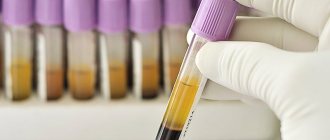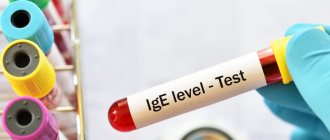Immunoglobulin A is an indicator of humoral immunity. It is determined to assess local immunity, the course of acute infectious processes, kidney diseases, liver diseases, and chronic inflammation. At the Yusupov Hospital, laboratory technicians use high-quality reagents to determine the level of immunoglobulins A. The results of the study are interpreted by professors and doctors of the highest category. Immunologists carry out therapy aimed at normalizing the concentration of immunoglobulins A. Therapists use effective drugs registered in the Russian Federation, which have minimal side effects.
Immunoglobulins A are proteins that provide local immunity. They are presented in the human body in two fractions: serum, which provides local immunity, and secretory. The secretory fraction is contained in milk, respiratory and intestinal secretions, tear fluid and saliva, which, together with nonspecific immune factors, protect the mucous membranes from viruses and bacteria.
Functions
Serum immunoglobulin A is a fraction of gamma globulins. It makes up 10-15% of the total amount of all soluble immunoglobulins. In blood serum, immunoglobulin A is represented mainly by monomeric molecules. The main amount of immunoglobulin A is not found in the blood serum, but on the surface of the mucous membranes. Secretory immunoglobulin facilitates the transport of immunoglobulin A across the epithelium. It protects immunoglobulin molecules from breakdown by digestive tract enzymes.
The main function of serum immunoglobulin A is to provide local immunity, protect the genitourinary, respiratory tract and digestive organs from pathogens of infectious diseases. Secretory antibodies have a pronounced anti-adsorption effect: they prevent the attachment of bacteria to the surface of epithelial cells, prevent the adhesion of microorganisms, without which bacterial damage to the cell becomes impossible. Also, immunoglobulins A, together with nonspecific immune factors, provide protection of mucous membranes from microorganisms. Congenital or acquired deficiency of immunoglobulin IgA can lead to allergies, autoimmune disorders, allergies, and repeated infections.
Immunoglobulin A does not cross the placental barrier. Its level in newborns is about 1% of the concentration in adults. By the first year of a child’s life, this figure is 20% of the adult level. After the baby is born, secretory immunoglobulins enter his body with the mother's colostrum. They protect the child’s gastrointestinal tract and respiratory tract. The age of 3 months is critical. During this period, doctors diagnose congenital or transient deficiency of local immunity. By the age of five, the level of immunoglobulin A reaches the concentration characteristic of an adult.
The level of immunoglobulin A in children depends on their age. In children from 3 to 12 months it is 0.02-0.05 g/l, from 12 to 16 years it is in the range of 0.6-3.48 g/l. In adults over 20 years of age, the normal level of immunoglobulin A varies from 0.9 to 4.5 g/l.
Take a blood test for total immunoglobulin E - Total IgE
Immunoglobulins are protein compounds produced by the body in response to allergens.
Immunoglobulins are produced by B lymphocytes. They are gamma globulins containing two chains. Fundamental differences in the structure of these chains contributed to the isolation of various types of immunoglobulins.
In response to the entry of a certain allergen into the body, one of the allergic response mechanisms is activated. In total, there are 4 types of allergic reactions. The most common type 1 reaction, or immediate type reaction. At the first meeting with an allergen, which most often in this type of reaction is a non-medicinal and non-infectious soluble antigen, a class E antibody is formed. When meeting the same allergen again, a chain of reactions is launched, namely: antibodies bind to the antigen, fixing on mast cells and basophils, which leads to the release of active substances - histamine, serotonin, etc. They lead to clinical manifestations of allergies - allergic rhinitis, bronchial asthma. The first type of reaction also includes anaphylactic shock, an acute condition that quickly develops in response to an encounter with an allergen.
Immunoglobulins E are characteristic of the first type of allergic reactions, and, consequently, their level in the blood increases in a number of allergic diseases. The most common are various types of hay fever, allergic rhinitis, bronchial asthma, and dermatitis. Since immunoglobulin E is normally present in the blood in a minimal concentration, a general blood test for immunoglobulin E
(Total IgE) helps to accurately determine the presence of an allergy or identify a predisposition to it.
In children, the immune system remains imperfect for some time, so the level of class E antibodies may be higher than normal values. But depending on how much the norm is exceeded, we can talk about the likelihood of an allergy. For example, if a child does not have signs of any allergy, but has a hereditary predisposition, then determining a high concentration of immunoglobulin E greatly increases the risk of developing an allergy in the near future. Of course, this is only the first stage of diagnosis, since the main goal in the presence of allergies is to identify the allergen. Immunoglobulins E are a summary reflection of the production of biologically active substances in response to an allergen. Other studies, namely allergen test panels, help determine which allergen they are produced for.
Special attention is paid to the diagnosis of helminthiases. These diseases are also associated with an increase in the level of immunoglobulin E, since any parasite is perceived by the body as a foreign protein, and its prolonged presence leads to the formation of antibodies against it. Therefore, when examining for this group of diseases, one of the studies is to assess the level of immunoglobulin E.
Phadia AB is a world leader in the development of systems for in vitro diagnostics of allergic and autoimmune diseases. Currently, ImmunoCAP® technology is recognized as the “gold standard” for allergy diagnostics and, according to independent studies, is the most accurate and stable.
Indications
With the help of immunoglobulins A, doctors assess the course of diseases that occur with activation of the immune system:
- acute and chronic infections of bacterial and viral origin; bronchial asthma;
- oncological diseases of the lymphatic system (leukemia, myeloma);
- connective tissue diseases (systemic lupus erythematosus, rheumatoid arthritis).
Immunoglobulin IgA is determined in the presence of the following diseases:
- recurrent bacterial respiratory infections (sinusitis, pneumonia), as well as otitis and meningitis, bronchial asthma;
- chronic diarrhea, malabsorption syndrome;
- anaphylactic post-transfusion reactions;
- Louis-Bar syndrome (ataxia - telangiectasia);
- tumor diseases of the lymphoid system (myeloma, leukemia, reticulosarcoma, lymphoma).
- chronic hepatitis, liver cirrhosis.
Using IgA immunoglobulin testing, doctors at the Yusupov Hospital check the functioning of the liver, stomach, intestines, and lymphatic system.
Immunoglobulin genes
Rice. 2. Scheme of gene rearrangement and biosynthesis of the immunoglobulin μ-chain.
The diversity of genes is ensured by the structure of their genes and DNA rearrangements. In the genomes of humans and mice there are three independent loci of genes of I. - ϰ, λ and H. Each of them includes a set of genes encoding variable domains and single genes of constant regions, and these groups of genes are located on the same level. distance from each other. The formation of light and heavy chains occurs as a result of recombination of one of the variable genes (V) with the gene encoding the constant region (C). Before each gene there is a section of DNA encoding a leader peptide (L). Between the V and C genes there are sequences (D segments and J segments) encoding small fragments of the polypeptide chain included in the variable regions.
The enormous diversity of I. is achieved as a result of: the existence of a large number of variable regions of V genes in each of the H-, ϰ - and λ -loci; recombination between V genes, D and J segments encoding fragments of variable domains; the variety of variants that arise at the border of connecting segments as a result of imprecise connection, deletion or inclusion will add. nucleotides; combinations between light and heavy chains. Additional I.'s diversity is determined by somatic point mutations that occur in rearranged genes.
During the maturation of B lymphocytes, a DNA rearrangement takes place, leading to the transfer of one of the V genes to one of the J segments (in the case of heavy chain genes, recombination first occurs between the D and J segments, Fig. 2). As a result of such V(D)J recombination, variable and constant regions, as well as transcriptional regulatory elements (promoters and enhancers), come closer together.
During the development of cells of the immune system, a change in the class of synthesized insulin may occur. It is determined genetically. a process involving a new rearrangement of DNA and called. "isotype switching" In this case, the heavy chains of one CH gene are replaced in the mature gene by another. The process does not affect either VH genes or light chain genes, and, therefore, the specificity of the proteins synthesized by a given cell remains unchanged. In some cases, a change in the class of the synthesized heavy chain is achieved through alternative splicing.
Collection of biomaterial for research
In order to determine the level of immunoglobulin A, venous blood is collected into an empty tube or with gel (to obtain serum). Patients with low levels of immunoglobulins on the eve of the study should take measures to prevent bacterial infection. The venipuncture site is pressed with a cotton ball until the bleeding stops. If a hematoma has formed at the site of the vein puncture. Apply a warm compress.
The patient is advised to refrain from eating for 12-14 hours before the test. He can drink pure still water. Doctors stop medications that may affect the results of the study. 3 days before taking blood, the patient must stop drinking alcohol. Analysis results can be obtained within 4 hours.
The structure of the immunoglobulin molecule
Rice. 1. Structure of the human IgG1 molecule: VH and VL – variable domains of the heavy and light chains, respectively; CL – light chain constant domain; CH1, CH2, CH3 – constant domains of t...
I. of different classes have structural and functional characteristics, but the general organization of molecules is preserved in all I. In most studied species of organisms, the monomeric I. molecule is built from four polypeptide chains: two identical heavy (H) and two identical light (L). The exception is I. fam. camelids and some species of sharks, where b. Part I contains only two heavy chains. I. molecules are symmetrical and are glycoproteins with a clearly defined domain structure; domains consisting of approximately 110 amino acid residues are homologous in primary structure and have a characteristic chain folding (Fig. 1). All 4 chains are connected by disulfide bonds, which are also present inside the domains, stabilizing the structure of the department. globular regions. The N-terminal domains differ significantly in different I. and are called. variable (V); VH and VL are the variable domains of the heavy and light chains, respectively. They form an antigen-binding center (Fab, or Fv), and there are two such centers for each monomeric molecule. The C-terminal part of each polypeptide within a class changes little and is called the constant (C) region. It includes one CL domain for light chains and three or four (depending on the class) CH domains for heavy chains. The variability of amino acid residues within V-domains is highest in short hypervariable regions (CDR1–CDR3), separated by the so-called. frame areas, which account for approx. 80% of the entire V domain. The framework regions maintain a uniform three-dimensional structure of V-domains, which is necessary to ensure contacts of hypervariable regions with antigens. The part of the I. molecule, consisting of the C-terminal domains of heavy chains, is designated as the Fc fragment. It mediates the binding of complement proteins, interaction with leukocyte receptors, and is connected to the rest of the molecule by a flexible “hinge” region, due to which the antigen-binding sections of the molecule have a certain spatial freedom.
There are 5 main ones. types of heavy chains (μ, δ, γ, α and ε), which contain 450–600 amino acid residues, and 2 types of light chains (ϰ and λ), including approx. 230 amino acid residues. Light chains ϰ and λ can be connected to any type of immunoglobulin heavy chain.
Reasons for the increase
Immunoglobulins A bind to microorganisms and delay their attachment to the cell surface. A decrease in the content of immunoglobulins A indicates a lack of local and general immunity. Their concentration increases in the following diseases:
- acute and chronic infectious processes (fungal, parasitic, bacterial);
- liver pathologies;
- multiple myeloma;
- systemic lupus erythematosus;
- monoclonal gammopathy.
The level of immunoglobulin A decreases in patients suffering from diseases that deplete the immune system. Immunoglobulin A may be low in a child with an acute viral infection
Immunoglobulin classes
There are 5 known classes of I. in humans: IgM, IgD, IgG, IgE and IgA. During both B-lymphocyte differentiation and the primary immune response, IgM is the first to be synthesized; they effectively fix complement and serve as the main antigen receptors on the surface of mature B lymphocytes, where they are present in the form of monomers; in blood serum are in the form of pentamers (include 5 monomers connected by J-chains). IgD is present in trace amounts in the blood serum of healthy people; perform the function of membrane receptors on the surface of B lymphocytes. IgG dominates in the serum of mammals (more than 75% of the total amount of antibodies) and forms the basis of the secondary (developing upon repeated encounter with the same antigen) immune response. They are able to penetrate the placenta, providing immune protection to the fetus. IgG are divided into 4 subclasses - IgG1, IgG2, IgG3, IgG4, the proportion of each of which in serum decreases in the indicated series. Most subclasses (IgG1, IgG2, IgG3) are capable of activating complement. All subclasses bind to the Fc receptors of polymorphonuclear leukocytes, and IgG1 and IgG3 also bind to the Fc receptors of monocytes. IgE interacts with Fc receptors of mast cells and basophils; when several IgE molecules associated with receptors come into contact with an antigen, these cells begin to secrete serotonin, histamine and other mediators, which can cause allergies. reactions and anaphylactic shock. IgA protects the mucous membranes, and also ensures the transfer of immunity from mother to newborn, and is divided into two subclasses: IgA1, present in the main. in the blood serum, and IgA2 contained in saliva, digests. juice, colostrum, nasal mucosa.
Decrease in indicator
Immunoglobulin A is reduced in patients with neoplasms of the lymphatic system, lymphoproliferative diseases, pernicious anemia, and hemoglobinopathies. The content of immunoglobulin A decreases after splenectomy, in case of protein loss due to enteropathies and nephropathies. Treatment with immunosuppressants, cytostatics, and exposure to ionizing radiation can also reduce the level of immunoglobulin IgA.
Long-term exposure to benzene, toluene, xylene, and taking medications: dextran, estrogens, methylprednisolone, carbamazepine, gold preparations, valproic acid can lower the level of immunoglobulin A. Get a consultation with an immunologist by making an appointment by calling the Yusupov Hospital. The doctor will conduct an examination and prescribe a test for immunoglobulin A levels.
Interpretation:
- Multiple myeloma IgA type, asymptomatic monoclonal IgA gammopathy, Wiskott-Aldrich syndrome, enteropathy, rheumatoid arthritis, autoimmune hepatitis, chronic purulent infections, liver diseases (cirrhosis, hepatitis), cystic fibrosis.
- Agammaglobulinemia (Bruton's syndrome), selective IgA deficiency, ataxia-telangiectasia (Louis-Bar syndrome), atopic dermatitis, transient infantile hypogammaglobulinemia, neoplasms of the lymphatic system, lymphoproliferative diseases, pernicious anemia, hemoglobinopathies.
Sample result (PDF)








